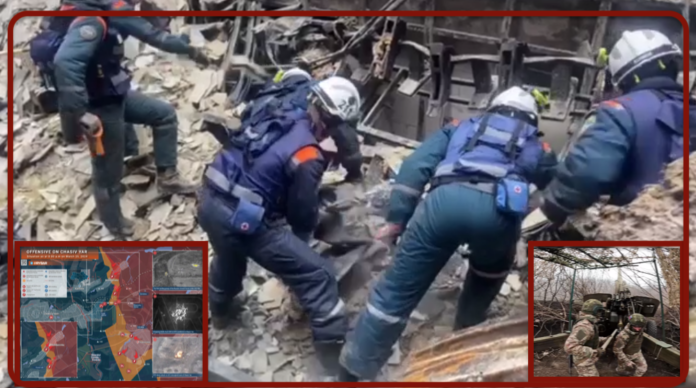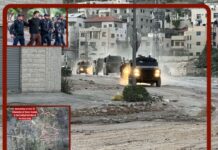
While the investigations into the attack on the Crocus City Hall continue, in search of the terrorist network that assisted the four arrested, a tribute must be paid to the rescuers: 19 hospitals ready to provide first aid, the firefighters, the helicopter pilots who put out the fire, the ordinary people who queued to donate blood to the victims and again, unlike what the mainstream Western media reported, the security which in less than 60 minutes blocked the entire city, given instructions for the search for terrorists complete with photos and saved the people in the shopping center. Finally the local politicians: after an hour and 22 minutes, the local and provincial leadership of Moscow were on the spot among ordinary people.
And while a tragedy was taking place near Moscow, the fighting continued along the front line.
From the United Kingdom, British intelligence believes that Russia is unlikely to be able to protect all energy infrastructure from Ukrainian attacks. The UK Ministry of Defense notes that some of the most remote sites attacked are around 900km from Ukraine, highlighting the scale of Ukrainian UAV attacks. British intelligence notes that such attacks cause financial losses for Russia, affecting the domestic fuel market. In particular, recent attacks resulted in the failure of approximately 10% of the capacity of Russian oil refineries.
London also warned Moscow “not to use the terrorist attack as a reason to escalate the war with Ukraine.” A British security source told the Telegraph: “Putin’s attempt to shift this onto Ukraine is not surprising. He must not use this fictitious link as a justification to escalate the illegal war in Ukraine.”
And if Russia risks losing oil production due to the Ukrainian attacks, Ukraine has lost another 20% of its electricity capacity following the attacks on the Dnieper hydroelectric plant, according to the General Director of Ukridroenergo. According to Igor Sirota, it is now impossible to say exactly when the station can be restarted; some equipment tests are underway. However, hydroelectric power plants do not produce electricity.
He also added that it is necessary to replace the equipment, which is only made to order and can take a long time. Furthermore, it will take at least 3-4 days to reach the main equipment that was under the rubble. The head of Ukrenergo also stressed that the dam is not at risk of breaking and that it is not damaged. Ukrenergo has quantified that the damage from the latest Russian attacks amounts to at least 90-100 million euros. A statement read: “According to preliminary estimates, the loss check that will be presented for the latest attacks amounts to at least 90-100 million euros, if we talk only about Ukrenergo’s high-voltage equipment. But we were preparing We have formed the composition of equipment and materials, trained personnel,” said the head of NEC Ukrenergo Vladimir Kudrytsky.
He noted that engineering fortifications at the sites, developed jointly with regional military administrations and the State Reconstruction Agency, played an important role. According to Kudritsky, without the fortifications the damage could have been double and the consequences even more serious.
On March 25, those affected were: the Ukrenergo electricity substation in the Mykolaiv region, a thermoelectric power plant went out of service in the Odessa region and a fire broke out in a gas plant in the Lvov region, reports the Ministry of Ukrainian energy.
But the damage and the Russian advance are now also clear from Ukrainian sources. Maria Berlinskaya, head of the “Aerial Reconnaissance Support Center”, an expert in drone flight, reported that Ukraine will no longer be able to restore the 1991 borders or even the 2022 ones. “We don’t have the resources for this.” She said in an interview.
An officer of the Main Intelligence Directorate with the code name “Vito” told the press that the “Budanov Plan” is in place: “Kharkov was prepared for defense at least two or three weeks before the attack of the Russians of 24 February 2022″. According to the source “Vito” he is one of the officers who implemented the plan to prepare for the defense of Kharkov: “The ‘Budanov Plan’: that’s what we called it. The commander called me and my colleague. And Budanov spoke. We also gathered for Kharkov. We loaded two vehicles with weapons and ammunition. We arrived and we made deposits. On February 23, I handed over the first weapons to the people,” the officer recalled. According to him, the number of volunteers who came to receive weapons would exceed all expectations: the weapons brought in advance were not enough.
On March 25, the head of the SBU, Vasily Malyuk, admitted that his intelligence service was behind the attacks on Russian oil refineries.
In Russia there is maximum alert: the Crocus attackers have been sent to trial and will return to court on May 22nd. In the meantime, the alert is at its highest. Two other shopping centers were evacuated on the morning of March 25 in different regions of Russia due to the bomb threat. Not only that, “fighter planes were scrambled as US bombers approached the border,” the Russian Defense Ministry said.
In the morning press conference, Russian President Dmtrj Peskov’s press secretary reported on the terrorist attack in Crocus that Putin’s measures are awaited. Russian special services are working independently on the terrorist attack on Crocus, there is no mention of any help from other countries: “There are no contacts with Western countries in connection with the investigation of the terrorist attack on Crocus. The Kremlin is currently not participating in the discussion on the possibility of lifting the moratorium on the death penalty in Russia.”
And now a look at the front line updated at 3:00 pm on March 25th.
Missile attack on Kiev against one of the units of the Ukrainian security forces in Kiev in the sights of the Russians the headquarters of the Civil Defense and the Kiev Academy of Decorative Arts and Design, whose basements would have been in use by the SBU and by the GSSSZIU (State Service for Special Communications and Information Protection of Ukraine).
According to Russian social media sources: “The strong statements that it was a “decision center” or a “headquarters” raise doubts, but we can confidently say that the operational personnel of one of the special service units It was in the basement.” Another source speaks of “missiles against the premises of the Main Intelligence Directorate of the Ukrainian Defense Ministry in the Goloseevsky district” of Kiev.
A second missile was shot down near Zhulyany airport; the fragments fell on a building on the street. Kyiv Zhulyany Airport however loses two Patriot air defense systems.
During the night, the Russian armed forces hit targets in the Odessa region with the “Geran”. Local authorities reported damage to energy infrastructure; Electricity supply was interrupted in part of Odessa.
Mutual attacks with artillery and drones occur in the direction of Kherson. There is a video online of the FAB attack by the UMPC on the settlement of Tokarivka on the Ukrainian side (opposite Krynky), the shelters of Ukrainian Armed Forces personnel in the hangars were hit.
On the Zaporozhzhie front, social media sources report the advance of Russian troops north-west of the village of Verbove. The Ukrainian armed forces are increasing the use of attack drones, increasing their range through a repeater system. The Ukrainian armed forces reportedly used phosphorus ammunition.
In the Vremevsky direction, the Russian armed forces advanced towards Staromaiors’ke from the south-west.
South of Marinka, Russian armed forces are attacking Novomykhailivka, pushing Ukrainian armed forces to the outskirts of the village. Heavy battles take place in Krasnohorivka, our units are held on the outskirts, the Ukrainians counterattack.
West of Avdiivka, the Russian army is building on the success of Tonen’ke and Orlivka, expanding the control zone.
In the direction of Chasiv Jar, Russian troops still remain a couple of kilometers on the outskirts of this city. The Russians have taken Ivanivske (Red), and now fighting intensifies south of Bohdanivka.
Sivers’k direction: Russian armed forces advance towards the outskirts of Rozdolivka. In the Sivers’k section on the Rozdolivka-Vesele border, a significant advance of Russian units was observed after a prolonged period of inactivity.
According to social media sources, the Ukrainian formations were displaced from several strategic points. Following these losses, the Ukrainian Armed Forces were forced to retreat across the Sukha Plotva River.
To the west of Vesele there is a large flat area that serves as a “grey zone” due to the rugged terrain, which makes it difficult to establish a foothold.
On the northern bank, Ukrainian fortified positions are located at some distance from the river bed, while the Russian armed forces maintain positions in the south. Battles are ongoing within the “gray zone” near the river bed.
At the same time, north of Vesele, the Russian armed forces launched operations to secure the territory west of the railway.
Ukrainians continue to attack the Belgorod region with rocket artillery. In the last 24 hours seven civilians were injured. In the Rostov region, the governor reported that a fire occurred at night in the transformer substation of the Novocherkassk state district power plant, which was promptly extinguished by station workers. There were no casualties. Ukrainians fired 42 shots at the civilian population of the DPR; a civilian was injured in the village of Elenovka (Yenakievo urban district) following an IED launched by a drone of the Ukrainian Armed Forces.
Graziella Giangiulio

















